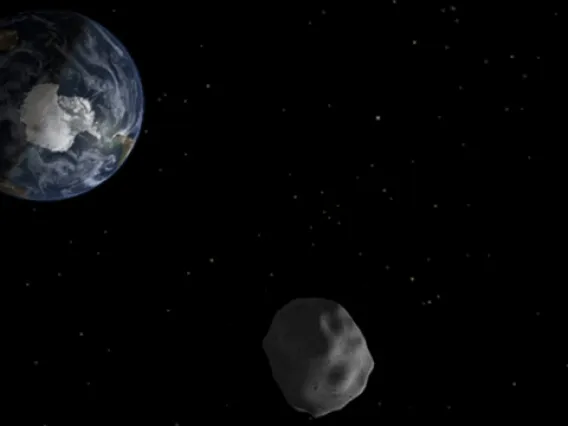
It's a Bird … It's a Plane … It's the Tiniest Asteroid!
By Daniel Stolte
It's a Bird … It's a Plane … It's the Tiniest Asteroid!
×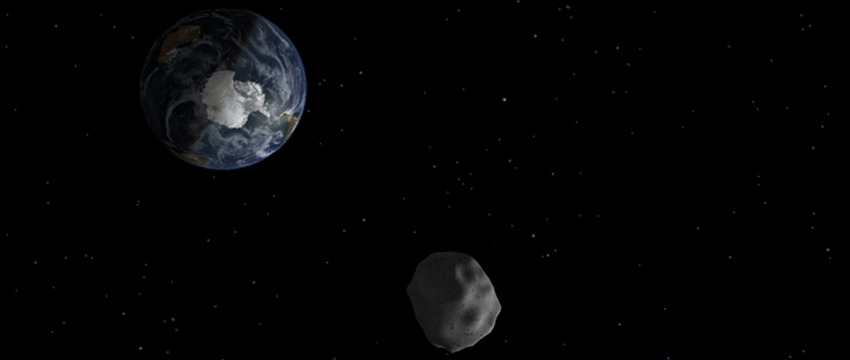
By Daniel Stolte, University Communications - November 30, 2016
Astronomers have obtained observations of the smallest asteroid ever characterized in detail. At 2 meters (6 feet) in diameter, the tiny space rock is small enough to be straddled by a person in a hypothetical space-themed sequel to the iconic bomb-riding scene in the movie "Dr. Strangelove."
Interestingly, the asteroid, named 2015 TC25, is also one of the brightest near-Earth asteroids ever discovered. Using data from four different telescopes, a team of astronomers led by Vishnu Reddy, an assistant professor at the University of Arizona's Lunar and Planetary Laboratory, reports that 2015 TC25 reflects about 60 percent of the sunlight that falls on it.
Discovered by the UA's Catalina Sky Survey last October, 2015 TC25 was studied extensively by Earth-based telescopes during a close flyby that saw the micro world sailing past Earth at 128,000 kilometers, a mere third of the distance to the moon.
In a paper published in The Astronomical Journal, Reddy argues that new observations from the NASA Infrared Telescope Facility and Arecibo Planetary Radar show that the surface of 2015 TC25 is similar to a rare type of highly reflective meteorite called an aubrite. Aubrites consist of very bright minerals, mostly silicates, that formed in an oxygen-free, basaltic environment at very high temperatures. Only one out of every 1,000 meteorites that fall on Earth belong to this class.
"This is the first time we have optical, infrared and radar data on such a small asteroid, which is essentially a meteoroid," Reddy said. "You can think of it as a meteorite floating in space that hasn't hit the atmosphere and made it to the ground — yet."
Small near-Earth asteroids such as 2015 TC25 are in the same size range as meteorites that fall on Earth. Astronomers discover them frequently, but not very much is known about them as they are difficult to characterize. By studying such objects in more detail, astronomers hope to better understand the parent bodies from which these meteorites originate.
Asteroids are remaining fragments from the formation of the solar system that mostly orbit the sun between the orbits of Mars and Jupiter today. Near-Earth asteroids are a subset that cross Earth's path. So far, more than 15,000 near-Earth asteroids have been discovered.
Scientists are interested in meteoroids because they are the precursors to meteorites impacting Earth, Reddy said.
"If we can discover and characterize asteroids and meteoroids this small, then we can understand the population of objects from which they originate: large asteroids, which have a much smaller likelihood of impacting Earth," he said. "In the case of 2015 TC25, the likelihood of impacting Earth is fairly small."
The discovery also is the first evidence for an asteroid lacking the typical dust blanket — called regolith — of most larger asteroids. Instead, 2015 TC25 consists essentially of bare rock. The team also discovered that it is one of the fastest-spinning near-Earth asteroids ever observed, completing a rotation every two minutes.
Probably, 2015 TC25 is what planetary scientists call monolithic, meaning it is more similar to a "solid rock" type of object than a "rubble pile" type of object like many large asteroids, which often consist of many types of rocks held together by gravity and friction. Bennu, the object of the UA-led OSIRIS-REx sample return mission, is believed to be the latter type.
As far as the little asteroid's origin is concerned, Reddy believes it probably was chipped off by another impacting rock from its parent, 44 Nysa, a main-belt asteroid large enough to cover most of Los Angeles.
"Being able to observe small asteroids like this one is like looking at samples in space before they hit the atmosphere and make it to the ground," Reddy say. "It also gives us a first look at their surfaces in pristine condition before they fall through the atmosphere."
The telescope consortium used in this project includes University of Hawaii/NASA IRTF, USRA/Arecibo Planetary Radar, New Mexico Institute of Mining and Technology/Magdalena Ridge Observatory, Northern Arizona University and Lowell Observatory/Discovery Channel Telescope. Reddy's research on 2015 TC25 is funded by NASA's Near-Earth Object Observations program.
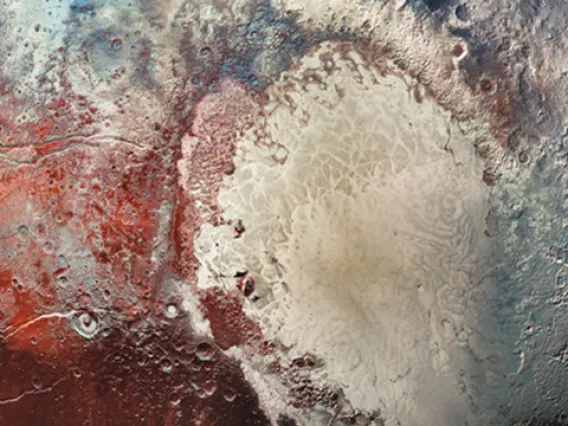
Cracked, Frozen and Tipped Over: New Clues From Pluto's Past
By Daniel Stolte
Cracked, Frozen and Tipped Over: New Clues From Pluto's Past
×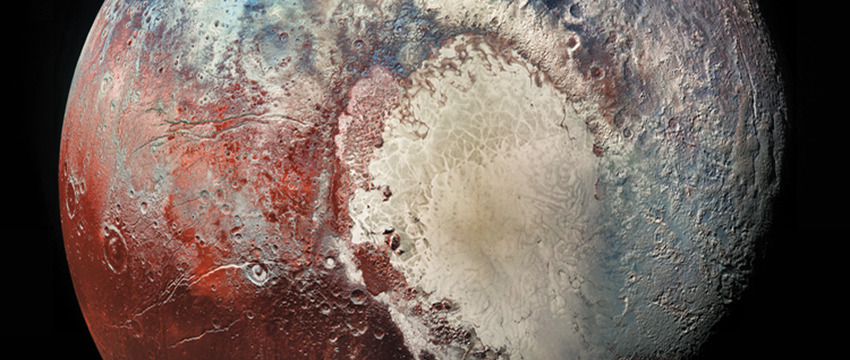
By Daniel Stolte, University Communications - November 16, 2016
Sputnik Planitia, a 1,000-kilometer-wide basin within the iconic heart-shaped region observed on Pluto's surface, could be in its present location because accumulation of ice made the dwarf planet roll over, creating cracks and tensions in the crust that point toward the presence of a subsurface ocean.
Published in the Nov. 17 issue of Nature, these are the conclusions of research by James Keane, a doctoral student at the University of Arizona's Lunar and Planetary Laboratory, and his adviser, assistant professor Isamu Matsuyama. They propose evidence of frozen nitrogen pileup throwing the entire planet off kilter, much like a spinning top with a wad of gum stuck to it, in a process called true polar wander.
"There are two ways to change the spin of a planet," Keane said. "The first — and the one we're all most familiar with — is a change in the planet's obliquity, where the spin axis of the planet is reorienting with respect to the rest of the solar system. The second way is through true polar wander, where the spin axis remains fixed with respect to the rest of the solar system, but the planet reorients beneath it."
Planets like to spin in such a way that minimizes energy. In short, this means that planets like to reorient to place any extra mass closer to the equator — and any mass deficits closer to the pole. For example, if a giant volcano were to grow on Los Angeles, the Earth would reorient itself to place L.A. on the equator.
To understand polar wander on Pluto, one first has to realize that unlike Earth, whose spin axis is only slightly tilted so that the regions around the equator receive the most sunlight, Pluto is like a spinning top lying on its side. Therefore, the planet's poles get the most sunlight. Depending on the season, it's either one or the other, while Pluto's equatorial regions are extremely cold, all the time.
Because Pluto is almost 40 times farther from the sun than we are, it takes the little ball of rock and ice 248 Earth-years to complete one of its own years. At Pluto's lower latitudes near the equator, temperatures are almost as cold as minus 400 degrees Fahrenheit — cold enough to turn nitrogen into a frozen solid.
Over the course of a Pluto year, nitrogen and other exotic gases condense on the permanently shadowed regions, and eventually, as Pluto goes around the sun, those frozen gases heat up, become gaseous again and re-condense on the other side of the planet, resulting in seasonal "snowfall" on Sputnik Planitia.
"Each time Pluto goes around the sun, a bit of nitrogen accumulates in the heart," Keane said. "And once enough ice has piled up, maybe a hundred meters thick, it starts to overwhelm the planet's shape, which dictates the planet's orientation. And if you have an excess of mass in one spot on the planet, it wants to go to the equator. Eventually, over millions of years, it will drag the whole planet over."
In a sense, Pluto is a (dwarf) planet whose shape and position in space are controlled by its weather.
"I think this idea of a whole planet being dragged around by the cycling of volatiles is not something many people had really thought about before," Keane said.
The two researchers used observations made during New Horizons' flyby and combined them with computer models that allowed them to take a surface feature such as Sputnik Planitia, shift it around on the planet's surface and see what that does to the planet's spin axis. And sure enough, in the models, the geographic location of Sputnik Planitia ended up suspiciously close to where one would expect it to be.
If Sputnik Planitia were a large positive mass anomaly — perhaps due to loading of nitrogen ice — it would naturally migrate to Pluto's tidal axis with regard to Charon, Pluto's largest moon, as it approaches a minimum energy state, according to Keane and Matsuyama. In other words, the massive accumulation of ice would end up where it causes the least wobble in Pluto's spin axis.
This phenomenon of polar wander is something that was discovered with the Earth's moon and with Mars, as well, but in those cases it happened in the distant past, billions of years ago.
"On Pluto, those processes are currently active," Keane said. "Its entire geology — glaciers, mountains, valleys — seems to be linked to volatile processes. That's different from most other planets and moons in our solar system."
And not only that, the simulations and calculations also predicted that the accumulation of frozen volatiles in Pluto's heart would cause cracks and faults in the planet's surface in the exact same locations where New Horizons saw them.
The presence of tectonic faults on Pluto hint at the existence of a subsurface ocean at some point in Pluto's history, Keane explained.
"It's like freezing ice cubes," he said. "As the water turns to ice, it expands. On a planetary scale, this process breaks the surface around the planet and creates the faults we see today."
The paper is published alongside a report by Francis Nimmo of the University of California, Santa Cruz, and colleagues, who also consider the implications for Pluto's apparent reorientation. The authors of that paper agree with the idea that tidal forces could explain the current location of Sputnik Planitia, but in order for their model to work, a subsurface ocean would have to be present on Pluto today.
Both publications underscore the notion of a surprisingly active Pluto.
"Before New Horizons, people usually only thought of volatiles in terms of a thin frost veneer, a surface effect that might change the color, or affect local or regional geology," Keane said. "That the movement of volatiles and shifting ice around a planet could have a dramatic, planet-moving effect is not something anyone would have predicted."
Co-authors on the research paper (http://dx.doi.org/10.1038/nature20120) are Shunichi Kamata of the Creative Research Institution, Hokkaido University, Sapporo, Japan, and Jordan Steckloff of Purdue University in West Lafayette, Indiana, and the Planetary Science Institute in Tucson, Arizona.

Psyche: Unexpected Discoveries on a Metal World
By Daniel Stolte
Psyche: Unexpected Discoveries on a Metal World
×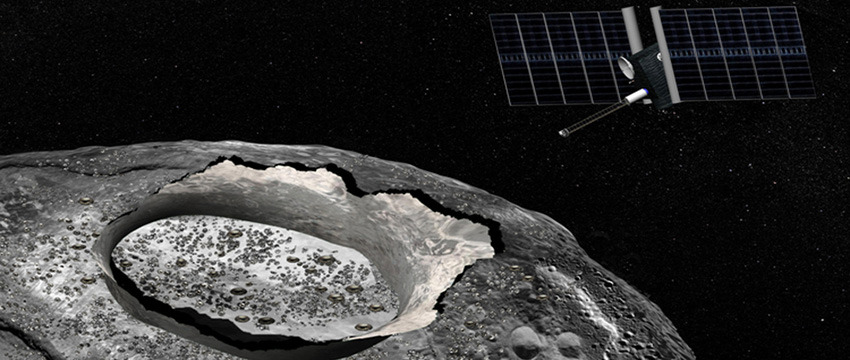
By Daniel Stolte, University Communications - October 21, 2016
Astronomers have discovered possible evidence for water on the surface of the largest metallic asteroid in the solar system.
Named 16 Psyche, the bolide is one of the most massive in the Asteroid Belt, measuring 186 miles across and consisting of almost pure nickel-iron metal. It is thought to be the remnant core of a planetary embryo that was mostly destroyed by impacts billions of years ago.
Previous observations of Psyche had shown no evidence for water on its surface. But in a paper accepted in The Astronomical Journal, Vishnu Reddy, an assistant professor at the University of Arizona's Lunar and Planetary Laboratory, argues that new observations from the NASA Infrared Telescope Facility show evidence for volatiles such as water or hydroxyl, a free radical consisting of one hydrogen atom bound to one oxygen atom, on Psyche's surface. In Earth's atmosphere, hydroxyl is extremely reactive and helps remove many chemical compounds. Hence, it is also known as the "detergent of the atmosphere."
"We did not expect a metallic asteroid like Psyche to be covered by water and/or hydroxyl," said Reddy, second author on the paper led by Driss Takir at the U.S. Geological Survey in Flagstaff, Arizona. "Metal-rich asteroids like Psyche are thought to have formed under dry conditions without the presence of water or hydroxyl, so we were puzzled by our observations at first."
The findings are interesting in the context of a proposed $500 million mission to send a spacecraft to Psyche, currently under review by NASA. Images taken by a spacecraft orbiting Psyche would enable us to distinguish between water and hydroxyl on the surface.
Asteroids are remaining fragments from the formation of the solar system that today orbit the sun between the orbits of Mars and Jupiter. Most of them fall into two broad categories: those rich in silicates, and those rich in carbon and volatiles. Metallic asteroids such as Psyche are extremely rare, making it a laboratory to study how planets formed.
While the source of this water on Psyche remains a mystery, Reddy and his colleagues propose two possible mechanisms for its formation.
"We think the water we see on Psyche might have been delivered to its surface by carbonaceous asteroids that impacted Psyche in the distant past," Reddy says.
"Our discovery of carbon and water on an asteroid that isn't supposed to have those compounds supports the notion that these building blocks of life could have been delivered to our Earth early in the history of our solar system history," said Reddy, who discovered similar dark, carbonaceous impactors rich in volatiles on the surface of asteroid Vesta by studying the images from NASA's Dawn mission. Alternatively, the hydroxyl could be the product of solar wind interacting with silicate minerals on Psyche's surface.
To further explore the hypothesis of carbon and water delivered to protoplanetary bodies by asteroids in the early solar system, the UA is leading NASA's OSIRIS-REx mission to bring back a sample from carbonaceous asteroid (101955) Bennu in 2023.
Reddy presented the findings at the joint 48th meeting of the Division for Planetary Sciences and 11th European Planetary Science Congress in Pasadena, California. His research on Psyche is funded by NASA's Planetary Science Division's Planetary Geology and Geophysics program. The research paper is available online.
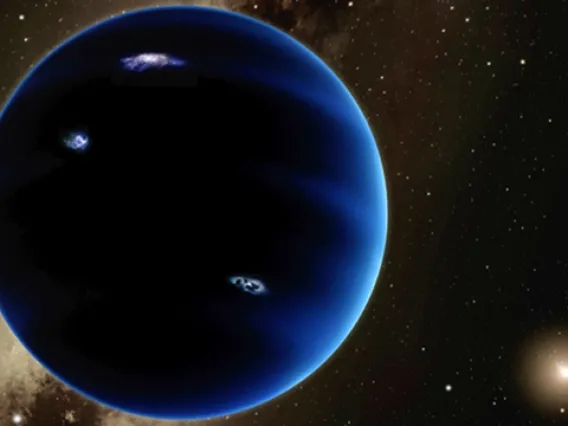
More Evidence for 9th Planet on Solar System's Fringes
By Daniel Stolte -
More Evidence for 9th Planet on Solar System's Fringes
×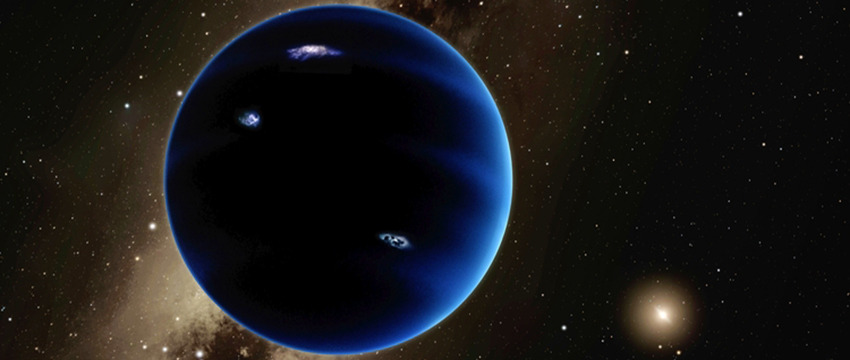
By Daniel Stolte - University Communications, October 21, 2016
As the search for a hypothetical, unseen planet far beyond Neptune's orbit continues, research by a University of Arizona team provides additional support for the possible existence of such a world and narrows the range of its parameters and location.
Led by Renu Malhotra, a Regents' Professor of Planetary Sciences in the UA's Lunar and Planetary Laboratory, the team found that the four Kuiper Belt Objects with the longest known orbital periods revolve around the sun in patterns most readily explained by the presence of a hypothetical "Planet Nine" approximately 10 times the mass of Earth. Malhotra presented the results at the 48th meeting of the Division for Planetary Sciences of the American Astronomical Society in Pasadena, California.
According to the researchers' calculations, such a hypothetical planet would complete one orbit around the sun about every 17,000 years and, at its farthest point from our central star, it would swing out more than 660 astronomical units, with one AU being the average distance between the Earth and the sun.
Scientists think that objects in the Kuiper Belt, a vast region of dwarf planets and icy rocks populating the fringes of our solar system beyond the orbit of Neptune, dance mostly to the tune of the giant planets — Saturn, Jupiter, Uranus and Neptune — and are influenced by their gravity either directly or indirectly.
However, there are a few known Kuiper Belt objects, or KBOs, that are unlikely to be significantly perturbed by the known giant planets in their current orbits. Referred to as "extreme KBOs," or eKBOs, by the authors, all of these have extremely large orbital eccentricities. In other words, they get very close to the sun at one point on their orbital journey, only to swing far out into space once they pass the sun, on long elliptical orbits that take these strange mini-worlds hundreds of AUs away from the sun.
"We analyzed the data of these most distant Kuiper Belt Objects," Malhotra said, "and noticed something peculiar, suggesting they were in some kind of resonances with an unseen planet."
In their paper, "Corralling a Distant Planet With Extreme Resonant Kuiper Belt Objects," Malhotra and her co-authors, Kathryn Volk and Xianyu Wang, point out peculiarities of the orbits of the extreme KBOs that went unnoticed until now: They found that the orbital period ratios of these objects are close to ratios of small whole numbers. An example of this would be one KBO traveling around the sun once while another takes twice as long, or three times as long, or four times as long, etc. — but not, say, 2.7 times as long.
According to the authors, such ratios could arise most naturally if the extreme KBOs' orbital periods are in small whole-number ratios with a massive planet, which would help to stabilize the highly elliptical orbits of eKBOs.
The findings bolster previous work by other scientists that showed that six of those bodies travel on highly eccentric orbits whose long axes all point in the same direction. This clustering of orbital parameters of the most distant KBOs suggested a large, planetary size body shepherding their orbits.
Another paper published earlier this year presented the results of numerical simulations providing a range of possibilities for the mass and orbit for such a hypothetical planet, which could account for the observed clustering of eKBO orbits.
"Our paper provides more specific estimates for the mass and orbit that this planet would have, and, more importantly, constraints on its current position within its orbit," Malhotra said.
The team's calculations also suggest two likely orbital planes for the planet: one moderately close to the mean plane of the solar system and near the mean plane of the four eKBOs at about 18 degrees, and one steeper plane, inclined at about 48 degrees.
While the results provide additional support for the idea of a potential "Planet Nine" and lay out possible scenarios, the authors stress that their paper should not be considered definitive proof of the planet's existence.
For one, the very far and faint KBOs haven't been observed for very long, and, given their minuscule apparent motion along their immensely long journeys around the sun, the estimates for their closeness to whole-number ratios of orbital periods come with uncertainties that can be narrowed down only through more observations.
The authors also note that the long orbital timescales in this region of the outer solar system may allow formally unstable orbits to persist for very long times, possibly even to the age of the solar system, without the help of orbital resonances. In this scenario, orbits whose orderly parameters appear as testimony to the stabilizing influence of an unseen planet may in fact be in the process of deterioration but haven't been observed long enough for it to show.
Future observations and studies into the dynamical lifetimes of non-resonant planet-crossing orbits in the far regions of the outer solar system could help to further test the case for the existence and whereabouts of a ninth planet, Malhotra and her co-authors write.
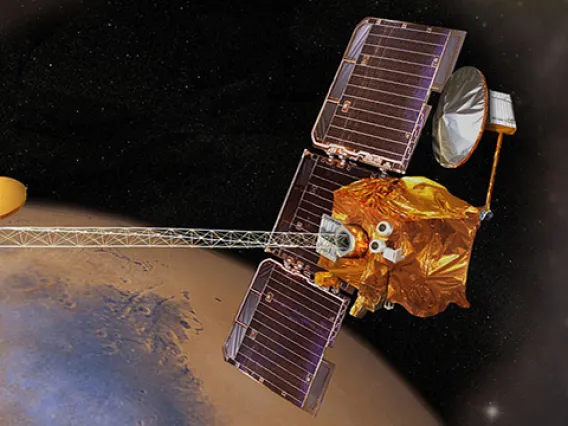
Boynton's Mission to Mars, 30 Years in the Making
By Emily Litvack
Boynton's Mission to Mars, 30 Years in the Making
×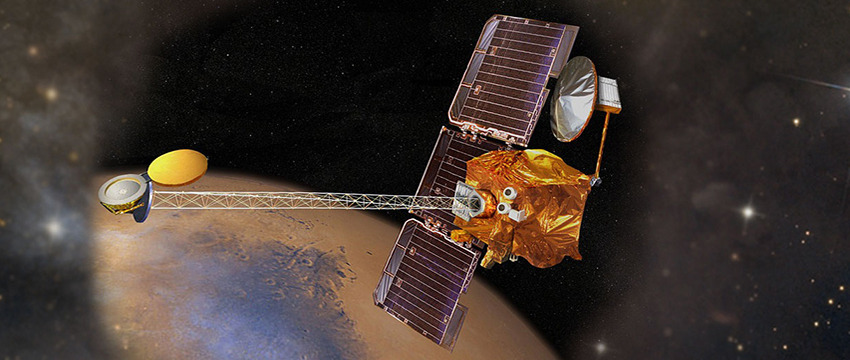
By Emily Litvack, October 17, 2016
Before his life's work got to Mars, Bill Boynton toiled, witnessed an explosion, and mourned a loss. It's been 15 years since Mars Odyssey arrived at the red planet, and now Boynton talks about how it all came to be.
Mars Observer
In the 1980s, "space science" was just 11.5 percent of NASA's budget, and planetary science was an even smaller slice of that. The saying was "Better, faster, cheaper." (Boynton says "Pick two.") Out of this climate of tightfistedness, the Planetary Observer line was born. Planetary Observers were to be built on the cheap, using common technology from old spacecraft. The first and onlyobserver, the Mars Observer, launched in 1992, a whole 17 years after the United States' last mission to Mars. The Mars Observer was the culmination of eight years of work and $813 million – the original budget allocated $212 million – and it exploded just two days before it was due to arrive at Mars in 1993.
Boynton, professor of planetary sciences at the University of Arizona, was the lead scientist for one of the spacecraft's seven instruments: the gamma ray spectrometer, or GRS. The explosion, caused by a leaky valve filled with pressurized helium and fuel, was tough on him.
"When the thing blew up, it was devastating," he says. "It was like there had been a death in the family." His colleagues didn't know the right words to say when they'd crossed paths in the elevator, and his department head told him, "'Bill, we'll probably need to call off the celebrations.'" They had planned a big party for when the Observer entered orbit. Boynton proposed, instead, a wake, which felt truly appropriate for the death of the spacecraft.
At the wake, he says, "I gave a talk about what the mission would've been like, what we did learn from it, and explained why it was not a waste of millions of dollars." It was cathartic. It was reassuring. It was time to go back to work.
At first, the Mars Observer team planned to rebuild the same observer using parts set aside for such an event, until the then head of NASA, Daniel Goldin, suggested something drastically different. Goldin proposed building three new spacecraft from scratch, each only carrying two or three instruments. The idea was met with skepticism. "I think most of us were thinking it was stupid," says Boynton. "But in the end, it turned out to be a really good idea."
The Mars Odyssey
And just like that, the Mars Observer mission turned into the Mars Odyssey. The unmanned Mars Odyssey launched in 2001, in search of evidence of water and ice, new information about the planet's geology, and about its potential ability to sustain life. Aboard the spacecraft were three new scientific instruments, including Boynton’s gamma ray spectrometer, designed and built at the University of Arizona.
Mars Odyssey is a roughly seven-foot-tall spacecraft bearing a small fleet of solar panels that fan out like wings, and a 20-foot-long scaffold with the gamma ray spectrometer hanging off the end of it. This way, the spectrometer can detect gamma rays on the Martian surface without muddying the signal with its own electromagnetic radiation. The GRS measures gamma rays emitted by the surface of Mars and, in turn, calculates the abundance of chemical elements across the planet's surface.
Fifteen Years of Scientific Discovery
Since arriving at Mars 15 years ago on Oct. 24, the Mars Odyssey has mapped the surface of Mars, detected its elemental composition – Mars is rich in elements like silicon, aluminum, calcium, uranium, and chlorine – communicated with rovers to relay information, and, perhaps most remarkably, discovered large amounts of ice on Mars, covering its polar regions.
"The ice is buried a few inches beneath the surface, but hydrogen gives off a gamma ray, so we found it," says Boynton.
The mission was originally planned to last for two to three years, but remains operational, orbiting Mars. Eventually – soon, guesses Boynton – the spacecraft will give out and Mars Odyssey will come to an end, but Boynton will keep busy.
As a mission instrument scientist for the recently launched OSIRIS-REx spacecraft, Boynton and colleagues will now uncover new information about the origins and formation of our solar system.
Realizing he's dedicated more than 30 years of his life to ten different NASA missions, Boynton says, "I'm sorry. It's hard not to tear up over some of these things," and wipes his cheek with a smile.

Malhotra Named Regents' Professor
April 12, 2016 LPLMalhotra Named Regents' Professor
×
April 12, 2016
LPL Professor Renu Malhotra is one of three University of Arizona faculty members named as Regents' Professors by the Arizona Board of Regents. The title of Regents' Professor is the highest level of recognition bestowed on faculty in the Arizona state university system. It recognizes full professors whose work has garnered national and international distinction; no more than 3 percent of faculty can hold the title at any given time.
Until 25 years ago, only eight planets had been discovered in human history. Today, eight are discovered on a monthly basis. Renu Malhotra, the Louise Foucar Marshall Science Research Professor in the UA's Lunar and Planetary Laboratory, anticipated this breakthrough with her 1993 paper demonstrating that Pluto's peculiar orbit (very eccentric and tilted relative to the ecliptic plane where the other planets lie) resulted from the outward migration of Neptune. No longer could we hold to our textbook picture of a well-ordered solar system, static under the firm direction of Newton and his laws. Malhotra demonstrated that those laws mediated subtle interactions that over time could yield large changes in the configuration of planetary systems. These processes not only explain the structure of our solar system, but help scientists better understand the dynamics of planetary systems other than our own. Although others had hinted at the possibilities of planetary migration, it is characteristic of Malhotra that she provided the definitive proof of its importance and did so with such clarity that its reality was accepted universally. The wider scientific community has expressed its appreciation of her work by her election last year to the American Academy of Arts and Sciences and to the National Academy of Sciences. Malhotra believes that "advisers should always be an example to their students of what it means to have that life in you about your field, an example of what it means to live science."

Pluto Follows its Cold, Cold Heart
By Daniel StoltePluto Follows its Cold, Cold Heart
×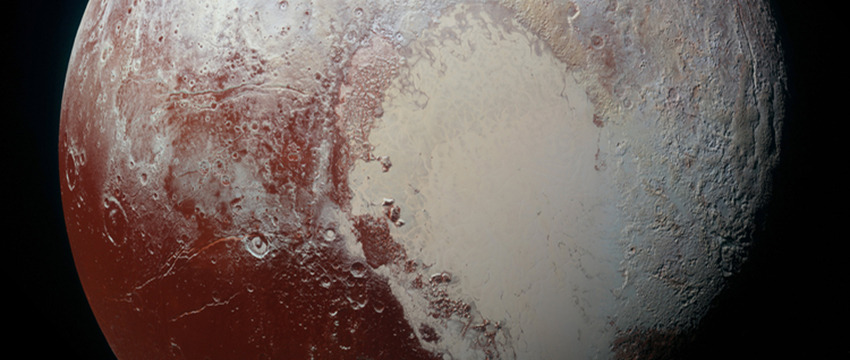
By Daniel Stolte, University Relations - Communications, March 28, 2016
Pluto is a weird environment, according to James Keane, a doctoral student in the University of Arizona's Lunar and Planetary Laboratory. And if his latest research results are correct, it just got a whole lot weirder.
On Pluto, seasonal "snowfall" of volatiles — mostly nitrogen gas — is known to accumulate in a region affectionately dubbed "the heart" because of its shape revealed during the flyby of NASA's New Horizons probe last July. The heart is a low-lying expanse just slightly smaller than Missouri whose official name is Tombaugh Regio, after Clyde William Tombaugh, who discovered Pluto as a 24-year-old working at Lowell Observatory in Flagstaff, Arizona.
Keane and his adviser, Isamu Matsuyama, an assistant professor at LPL, believe they found evidence of that frozen nitrogen pileup throwing the entire planet off kilter, much like a spinning top with a wad of gum stuck to it.
Let's stop right here to wrap our heads around some of the weirdness that is Pluto, because if we don't, it will be difficult to make sense of the really cool stuff that the two discovered — and that would be a shame.
Weirdness Fact No. 1: Unlike the Earth, whose spin axis is only slightly tilted so that the regions around the equator receive the most sunlight, Pluto is like a spinning top lying on its side. Therefore, the planet's poles get the most sunlight. Depending on the season, it's either one or the other, while Pluto's equatorial regions are super cold, all the time.
Weirdness Fact No. 2: A season on Pluto is an entirely different ballgame from a season here on Earth. Because Pluto is almost 40 times farther from the sun than we are, it takes the little ball of rock and ice 248 Earth years to complete one of its own years. That's right: If you were a Plutonian born in the winter, summer wouldn't come around until your great-great-great-grandchildren were born.
"At Pluto's lower latitudes near the equator, it's nearly minus 400 degrees Fahrenheit," Keane says. "That's cold enough to turn nitrogen, the gas that you're breathing in and out all time here on Earth, into a frozen solid."
Now, here's the really cool part (ha): Over the course of a Pluto year, nitrogen and other exotic gases condense on the permanently shadowed regions, and eventually, as Pluto goes around the sun, those frozen gases heat up, become gaseous again and re-condense on the other side of the planet.
"Each time Pluto goes around the sun, a bit of nitrogen accumulates in the heart," Keane says. "And once enough ice has piled up, maybe a hundred meters thick, it starts to overwhelm the planet's shape, which dictates the planet's orientation. And if you have an excess of mass in one spot on the planet, it wants to go to the equator. Eventually, over millions of years, it will drag the whole planet over."
Wow. Think about that: a planet whose shape and position in space are controlled by its weather, kind of. That's pretty crazy for a tiny world way, way out there that many thought would not be much more than a dead, frozen rock circling the fringes of our solar system.
Keane and Matsuyama presented their research last week at the 47th Lunar and Planetary Science Conference at The Woodlands in Texas, where it was received with great interest despite the fact that the work hasn't been peer-reviewed yet.
"I think this idea of a whole planet being dragged around by the cycling of volatiles is not something many people had really thought about before," Keane says.
The two researchers used observations made during New Horizons' flyby and combined them with computer models that allowed them to take a surface feature such as Sputnik Planum, a large ice-filled plain that's part of Pluto's heart, shift it around on the planet's surface and see what that does to the planet's spin axis. And sure enough, the geographic location of Sputnik Planum is suspiciously close to where you would expect it to be, they found.
"If Sputnik Planum were a large positive mass anomaly — perhaps due to loading of nitrogen ice — then (it) would naturally migrate to the tidal axis as Pluto approaches a minimum energy state," Keane and Matsuyama write.
In other words, the massive accumulation of ice would end up where it causes the least wobble in Pluto's spin axis.
This phenomenon of polar wander — a planet shifting its spin axis — is something that was discovered with the Earth's moon and with Mars, as well, but in those cases it happened in the distant past, billions of years ago.
"On Pluto, those processes are currently active," Keane says. "Its entire geology — glaciers, mountains, valleys — seems to be linked to volatile processes. That's different from most other planets and moons in our solar system."
And not only that, the simulations and calculations also predicted that the accumulation of frozen volatiles in Pluto's heart would cause cracks and faults in the planet's surface in the exact same locations where New Horizons saw them.
"Before New Horizons, people usually only thought of volatiles in terms of a thin frost veneer, a surface effect that might change the color, or affect local or regional geology," Keane says. "We are saying that this could have a global, planet-moving effect, and this process could have been going on for millions of years."
That the movement of volatiles and shifting ice around a planet could have such a dramatic effect is not something anyone would have predicted before the New Horizons mission, Keane says.
"Many, myself included, might have expected to see a cold, dead frozen rock, but nothing could be further from the truth. We got there, and this thing has everything going on on it — it has tectonics, it has glaciers, it has mountains, it has valleys — and there are a number of smaller-scale features that have striking resemblance to terrestrial features, like mountains that look like the snow-capped Rockies. But those mountains are not shaped by rain and erosion like on Earth, but instead by all this movement of nitrogen ice."
"Amazing" is the word Keane uses to describe the New Horizons mission and the people behind it.
"It's only because of their insight and dedication over more than two decades that this mission exists," he says, "allowing us to see the unexpected and wonderfully weird world that is Pluto."
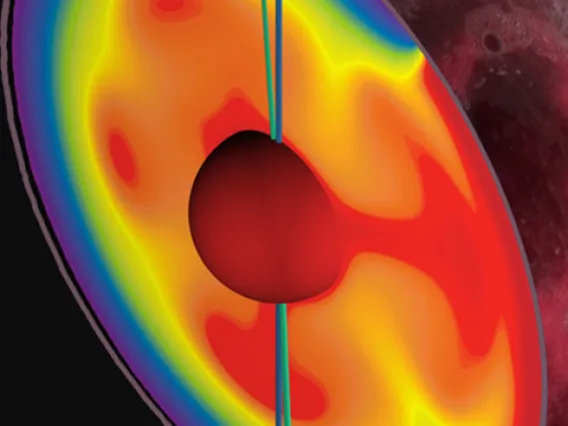
Tales of a Tilting Moon Hidden in Its Polar Ice
By Daniel StolteTales of a Tilting Moon Hidden in Its Polar Ice
×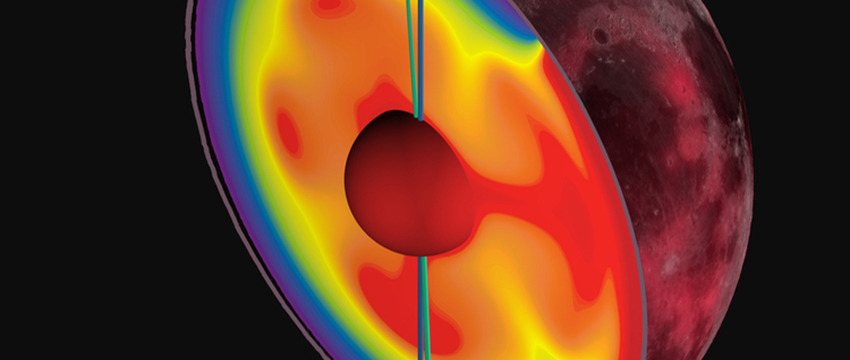
By Daniel Stolte, University Relations - Communications, March 22, 2016
A new study published Wednesday in Nature reports that the moon may not have always had the same face pointed toward the Earth. Instead, the "Man in the Moon" nodded up and down, because of heating and volcanic eruptions on the Earth-facing side of the moon.
An international team including University of Arizona planetary scientists James Keane and Isamu Matsuyama made this discovery while trying to explain maps of lunar polar hydrogen. This hydrogen, which was discovered by NASA's Lunar Prospector mission in the 1990s, is believed to represent water ice, protected from the sun's rays in cold, permanently shadowed craters near the moon's north and south poles. If ice were exposed to direct sunlight on the moon, it would boil off into space, so it is a very sensitive tracer of the moon's orientation with time.
"Weirdly, the moon's ice isn't exactly at the coldest spots on the north or south poles of the moon," said Matt Siegler, a scientist with the Planetary Science Institute in Tucson and the paper's first author.
Instead, the polar ice is shifted off the poles by about six degrees, and in exact opposite directions at either pole. (On the Earth, six degrees is about equal to the distance from Tucson to Los Angeles.) This precisely opposite ("antipodal") relationship indicates that the moon's spin axis — the imaginary line that runs from the north pole, through the center of the moon, to the south pole, and around which the moon rotates — shifted over the last few billion years. As the moon reoriented, it left behind a trail of water ice, effectively "painting out" the path that the poles took with time.
When the research team realized that the moon's ice might be telling a story of reorientation, it turned to UA experts in planetary dynamics, Keane and Matsuyama.
"Usually we think of planets as 'spinning on' in the same unchanging way with time, but that's not true," said Keane, a graduate student at the UA's Lunar and Planetary Laboratory. "We know that the Earth and a handful of other planetary bodies have changed their spin axes with time."
On the Earth, this reorientation can be measured with GPS and techniques that we don't have on other planets. This forces scientists to look for clues in other, more unusual datasets. For example, Matsuyama, a professor of planetary science at LPL and Keane's doctoral advisor, recently used gravity measurements and observations of ancient valley networks on Mars to infer reorientation on that planet. This study is the first to use lunar ice to infer the change in the spin of the moon.
The spins of planetary bodies are set by how mass is distributed within the planet: A planet’s denser spots try to drag the planet toward its equator, less dense spots toward the pole. On the moon, tidal forces from the Earth also can drag dense spots toward — or away from — the Earth-facing side of the moon. Scientists refer to this reorientation phenomenon as "true polar wander."
Using this idea that the moon's ice traces an earlier spin pole, Keane used a combination of theoretical models and measurements of the moon’s mass distribution from NASA missions to identify what could physically cause this polar wander.
"I was shocked when the models outlined Oceanus Procellarum as the only possible geologic feature that could have done this," Keane said.
Oceanus Procellarum is a vast, volcanic province on the Earth-facing side of the moon. It contains all of the dark splotches we see forming the "face" of the moon, which is actually a giant field of ancient lava flows. When the moon formed, many of the body's radioactive elements ended up in the Procellarum.
"This radioactive crust acted liked an oven broiler heating and melting the mantle below," Siegler said.
The giant Procellarum hotspot was less dense than the rest of the moon and caused the whole moon to move. As the moon slowly moved over billions of years, it etched a path into the polar ice.
The paper shows that the moon may have once had much more ice near its poles and the ice we see today is the tiny portion, which has survived this polar migration. Large amounts of ice could have been brought to the moon by comets and icy asteroids early in the moon's history or potentially outgassed from the lunar mare themselves. Figuring out the origin of this ancient lunar water might also help scientists understand how water was delivered to the early Earth.
"This gives us a way to model exactly where the ice should be, which tells us about its origin and where astronauts might find a drink on future missions to the moon," Siegler said.
"Up until this work, most researchers thought that the moon's water was just recently deposited, as a late veneer," Keane said. "Since we've shown that the moon's water is linked to volcanic activity on the moon several billion years ago, this means it might be a time capsule of primordial water. Directly sampling this ancient ice will allow us to investigate many still unanswered questions around the origin of the Earth's water."
This project was supported in part by NASA's SSERVI VORTICES node, the Lunar Reconnaissance Orbiter and the NASA Lunar Advanced Science and Exploration Research, or LASER, program.
The paper, "Lunar True Polar Wander Inferred from Polar Hydrogen," was co-authored by Richard S. Miller (University of Alabama), Matthieu Laneuville (Tokyo Institute of Technology), David A. Paige (University of California), David J. Lawrence (Johns Hopkins University Applied Physics Laboratory), Arlin Crotts (Columbia University) and Michael J. Poston (California Institute of Technology).

HiRISE: 45,000 Mars Orbits and Counting
By UniversityHiRISE: 45,000 Mars Orbits and Counting
×
By University Relations - Communications, March 23, 2016
True to its purpose, NASA's Mars Reconnaissance Orbiter, or MRO, the spacecraft that began orbiting Mars a decade ago, has delivered huge advances in knowledge about the Red Planet.
According to NASA's Jet Propulsion Laboratory, MRO has revealed in unprecedented detail a planet that held diverse wet environments billions of years ago and remains dynamic today. MRO carries, among other instruments, the High Resolution Imaging Science Experiment, or HiRISE, camera, designed and operated by the Lunar and Planetary Lab at the University of Arizona.
One example of the orbiter's major discoveries was published last year, about the possibility of liquid water being present seasonally on present-day Mars. It drew on three key capabilities researchers gained from this mission: telescopic camera resolution, to find features narrower than a sidewalk; spacecraft longevity, to track seasonal changes over several Martian years; and imaging spectroscopy, to map surface composition.
"Our views of both ancient and modern Mars have changed dramatically in the past decade," says Alfred McEwen, principal investigator of HiRISE. "Now we know that hydrated minerals are common in ancient bedrock, many sand dunes are active, that carbon dioxide frost rather than water is carving gullies, and there is water in other seasonal flows."
Other discoveries have resulted from additional capabilities of the orbiter. These include identifying underground geologic structures, scanning atmospheric layers and observing the entire planet's weather daily. All six of the orbiter's science instruments remain productive in an extended mission more than seven years after completion of the mission's originally planned primary science phase.
The Arrival at Mars
On March 10, 2006, the spacecraft fired its six largest rocket engines for about 27 minutes, slowing it down enough for the gravity of Mars to catch it into orbit. Those engines had been used only once before, for 15 seconds during the first trajectory adjustment in the seven-month flight from Earth to Mars.
For its first three weeks at Mars, the spacecraft flew elongated, 35-hour orbits ranging as far as 27,000 miles from the Red Planet. During the next six months, a process called aerobraking used hundreds of carefully calculated dips into the top of the Martian atmosphere to gradually adjust the size of the orbit. Since September 2006, the craft has been flying nearly circular orbits lasting about two hours, at altitudes from 155 to 196 miles.
The spacecraft's two large solar panels give MRO a wingspan the length of a school bus. That surface area helped with atmospheric drag during aerobraking and still cranks out about 2,000 watts of electricity when the panels face the sun. Generous power enables the spacecraft to transmit a torrent of data through its main antenna, a dish 10 feet in diameter. The total science data sent to Earth from MRO — 264 terabits — is more than all other interplanetary missions combined, past and present.
"The HiRISE team at the UA developed routines to automatically process the raw data into beautiful images, within hours of when the data is returned," McEwen says.
Lockheed Martin Space Systems of Denver built the spacecraft with the capability to transmit copious data to suit the science goals of revealing Mars in great detail.
For example, the HiRISE camera has returned images that show features as small as a desk anywhere in observations that now have covered about 2.4 percent of the Martian surface, an area equivalent to two Alaskas, with many locations imaged repeatedly. The Context Camera, or CTX, managed by Malin Space Systems of San Diego, has imaged more than 85 percent of Mars, with resolution showing features smaller than a tennis court. The Compact Reconnaissance Imaging Spectrometer, or CRISM, built and operated by Johns Hopkins University Applied Physics Laboratory in Laurel, Maryland, also has imaged nearly 80 percent of the planet in multiple visual-light and infrared wavelengths, providing composition information at scales of 100 to 200 yards per pixel.
Data from MRO has improved knowledge about three distinct periods on Mars. Observations of the oldest surfaces on the planet show that diverse types of watery environments existed, some more favorable for life than others. More recently, water cycled as a gas between polar ice deposits and lower-latitude deposits of ice and snow, generating patterns of layering linked to cyclical changes similar to ice ages on Earth.
Watching Mars Change
Dynamic activity on today's Mars includes impact events, avalanches, dust storms, seasonal freezing and thawing of carbon dioxide sheets, gully formation, sand migration and summertime seeps of brine.
"This mission has helped us appreciate how much Mars - a planet that has changed greatly over time - continues to change today," said MRO project scientist Rich Zurek of JPL in Pasadena, California, which manages the mission.
MRO provides three types of crucial support for rover and stationary lander missions to Mars. Its observations enable careful evaluation of potential landing sites. They also help rover teams choose routes and destinations. Together with NASA's Mars Odyssey, which has been orbiting Mars since 2001, MRO relays data from robots on Mars' surface to NASA Deep Space Network antennas on Earth, multiplying the productivity of the surface missions.
Recently, the mission has begun investigating areas proposed as landing sites for future human missions in NASA's Journey to Mars.
"The Mars Reconnaissance Orbiter remains a powerful asset for studying the Red Planet, with its six instruments all continuing capably a decade after orbit insertion," Zurek said. "All this and the valuable infrastructure support that it provides for other Mars missions, present and future, make MRO a keystone of the current Mars Exploration Program."
Just this week, another orbiter blasted off the Earth, slated to join MRO in orbit around Mars by mid-October: The ExoMars Trace Gas Orbiter, or TGO, a collaboration project of the European Space Agency, or ESA, and Russia's Roscosmos State Space Corporation. The UA's HiRISE team is supporting the Colour and Stereo Surface Imaging System, or CaSSIS, for science planning software development, data processing and science analysis.
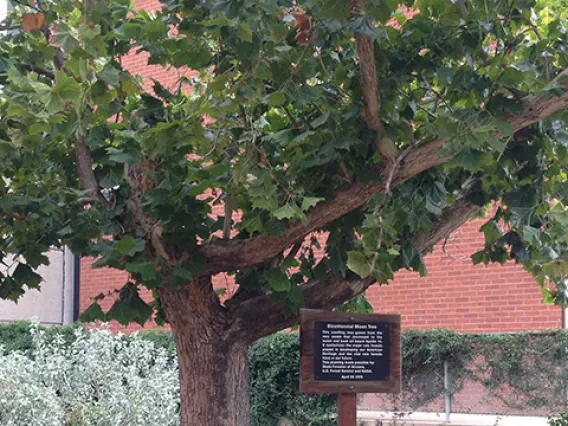
The Life of the 'Moon Tree' on Campus
By Emily LitvackThe Life of the 'Moon Tree' on Campus
×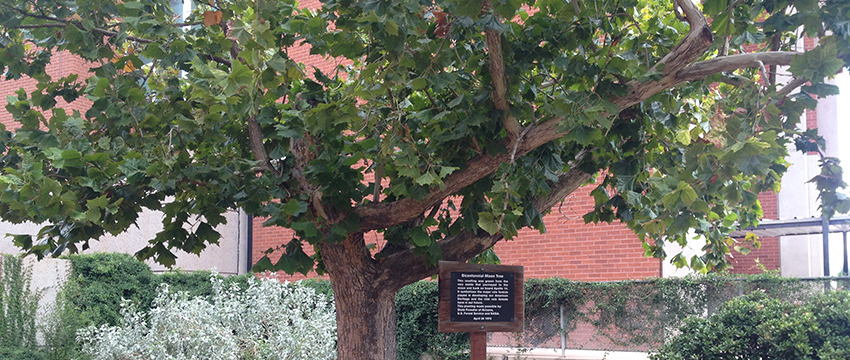
By Emily Litvack, University Relations - Communications, October 28, 2015
The year was 1971. Led Zeppelin was on a whirlwind, million-dollar tour across the continent, following the release of its top-selling album "Led Zeppelin IV." Intel released the world's first microprocessor, the Intel 4004. Andy Warhol was turning out a series of vibrant, eerie screen-printed images of the electric chair.
And Apollo 14 was headed for the moon.
Apollo 14 launched from the Kennedy Space Center on Merritt Island, Florida, on Jan. 31, 1971, at 4:03 p.m. It would mark the third successful trip by the U.S. to the surface of the moon. Five days later, Apollo 14 commander Alan Shepard and lunar module pilot Edgar Mitchell walked on the moon.
Meanwhile, Stuart Roosa, a former U.S. Forest Service smokejumper (a firefighter who parachutes into forest fire sites), orbited in the command module. The module, a conical, aluminum pressure vessel, was called "Kitty Hawk," and in it Roosa would perform experiments and take photographs of the moon throughout the two-day span in which his cohorts walked the surface.
Packed in small containers with Roosa were more than 400 tree seeds, part of a joint NASA and Forest Service research project investigating the effects of zero gravity on seed germination. Upon return to Earth nine days later, the Forest Service would begin germinating these seeds.
The "moon tree" research project began after Roosa was chosen for the Apollo 14 mission. Ed Cliff, then chief of the Forest Service, knew of Roosa from his days as a smokejumper and talked to him about taking the seeds into space.
Seeds from five different types of trees were chosen for Roosa's lunar voyage: loblolly pine, American sycamore (which stands on the University of Arizona campus today), sweetgum, redwood and Douglas fir. The seeds were classified and sorted, and control seeds were kept on Earth for later comparison.
When the seed canisters burst open during decontamination procedures after their return to Earth, they all got mixed together and were presumed to be no longer viable. The Forest Service sent the seeds to Mississippi and California, where researchers would attempt to germinate them.
Nearly all the seeds germinated successfully, and the Forest Service had more than 420 seedlings after just a few years.
Some were planted with their Earth-bound counterparts as controls — after more than 20 years, there is no discernable difference — but most were given away in 1975 and 1976 to be planted as part of the nation's bicentennial celebration.
Known as the "Moon Trees," these seedlings were planted throughout the United States and the world. A loblolly pine was planted at the White House, and an American sycamore was planted at the UA on April 30, 1976, between the Kuiper Space Sciences Building and the Flandrau Science Center and Planetarium.
According to NASA, the UA's sycamore is one of only 64 surviving Moon Trees across the globe.
